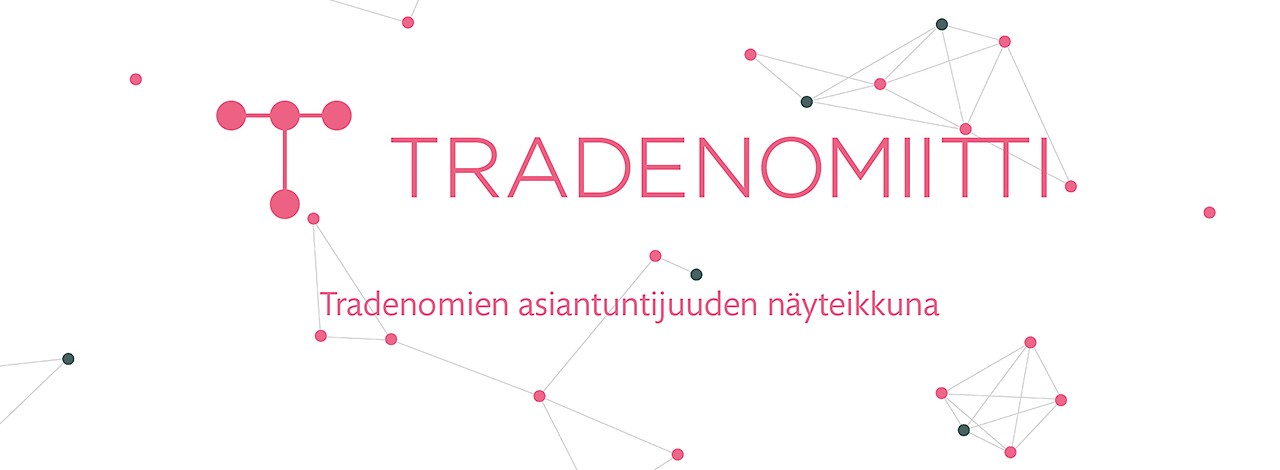Mitä TRAL edellä - sitä muut perässä / TRAL goes ahead and other ones follow
15.11.2017
In english below
Vuonna 2006 kiersin ympäri Suomea opiskelija-asiamiehenä ja tapasin tuhansia innokkaita opiskelijoita. Usein esille nousi sama havainto: tradenomiopiskelija ei ole välttämättä koskaan kohdannut elävää tradenomia. Ymmärrettävästi voi olla turhauttavaa opiskella tutkintoa, jonka tarjoamista uramahdollisuuksista ei ole kunnollista käsitystä.
Keskustelimme asiasta kollegani kanssa, joka oli tehnyt samoja havaintoja ja ideoimme erilaisia ratkaisuja ongelmaan. Tuolloin aika ei vielä kuitenkaan ollut kypsä mielessämme muhineelle palvelulle, joka tulisi tarjoamaan vastauksen moneen kysymykseen.
Vettä virtasi Vantaassa kymmenen vuoden ajan, kunnes löysimme ongelmaan ratkaisun ja sivutuotteena muutamia muitakin hyötyjä. Teimme paljon pohjatyötä, jotta löysimme parhaan mahdollisen kumppanin toteutukseen. Tämän jälkeen aloitimme projektin tärkeimmän vaiheen - konseptoinnin. Palvelua pohdittiin Futuricen tiimin kanssa intensiivisesti kaksi viikkoa putkeen suljetussa huoneessa ja jokaista merkittävää päätöstä testattiin huolella haastattelemalla potentiaalisia käyttäjiä. Tuloksena syntyi yksityiskohtainen suunnitelma, jota lähdettiin toteuttamaan ketterästi jälleen käyttäjiä huolellisesti kuunnellen.
Kymmenen vuotta ongelman tunnistamisen jälkeen oli syntynyt Tradenomiitti, ja tänään sen myötä syntyy aitoja kohtaamisia eri uravaiheissa olevien tradenomien ja tradenomiopiskelijoiden välillä.

Tradenomiitti on malliesimerkki siitä, kuinka havaittuun ongelmaan lähdetään hakemaan päättäväisesti ratkaisua. Toinen paljon käytetty keino uusien palveluiden suunnitteluun on jäsenten kuunteleminen herkällä korvalla. Pyydämme kaikissa mahdollisissa tilanteissa jäseniltä palautetta ja ideoita, joiden ansiosta tilannekuva pysyy jatkuvasti kirkkaana silmien edessä.
Ideoita jäseniltä saammekin paljon. Niiden toteuttaminen vaatii kuitenkin monen asian huomioimista, joista tärkeimpänä on riittävän suuren hyödyn tarjoaminen mahdollisimman suurelle osalle jäsenistä suhteessa kustannuksiin. Etujen suunnittelussa tulee hyödyntää suuren jäsenmäärän tuomaa painoarvoa.
Palveluiden suunnittelussa toinen tärkeä arvioitava seikka on palvelun kriittisen pisteen arviointi. Tarkoitan sillä palvelun käyttäjien oletettua määrää eli todellista tarvetta ja sen tuottamiseen sitoutuvien resurssien välistä suhdetta.
Kriittisen pisteen tunnistamisesta hyvinvointi- ja työkykyohjauksen aloittaminen on hyvä esimerkki. Työsuhdelakimiehemme raportoivat jatkuvasti enemmän ja enemmän tilanteista, joissa jäsenet olivat yhteydessä kiusaamisen, kohtuuttoman työkuorman tai jopa alentuneen työkyvyn takia. Näissä teemoissa ei kuitenkaan ole kovin usein juridista tarttumapintaa, joten lakimiehillä ei ollu paljon eväitä auttaa.
Kartoitimme tilannetta ja löysimme kumppanin, joka on erikoistunut hyvinvoinnin ja työkyvyn ongelmien selvittämiseen. Aloitimme toimivan yhteistyön ja vuoden 2017 alusta alkaen jäsenmaksuun sisältyvän palvelun käyttöaste yllätti kaikki positiivisesti. Jäsenten palaute on ollut ylistävää, vihdoinkin joku pystyy tarjoamaan apua työelämän vaikeimpiin tilanteisiin.
Yhteistä lähes kaikille TRAL:n palveluille on edelläkävijyys. Vuosikausien ajan on toteutunut tilanne, jossa me kehitämme ensin palvelun ja muut liitot tekevät saman myöhemmin. Mainittakoon vaikkapa, että Tradenomiitti-palveluun tekemäämme avointa lähdekoodia käyttäviä palveluita on jo kehitteillä, Digijuristi-palvelusta on käytössä muutamilla liitoilla lähes täysin kopioitu versio sekä hyvinvointiohjausta on tarjolla nykyään muillakin liitoilla. Tämä proaktiivinen uudistuminen on yksi tapa, jolla keskikokoinen liitto voi uudistaa koko toimialaa ja pakottaa muutkin liitot kehittämään palveluitaan nykyaikaisiksi.

Tomi Kouva
palvelu- ja kehitysjohtaja
Tradenomiliitto TRAL
In 2006, I travelled around Finland as a student advisor and met thousands of enthusiastic students. The same observation often came up: a BBA student may not have ever encountered live BBA’s. Understandably, it may be frustrating to study a degree that the offered career prospects are unknown.
We discussed this with my colleague who had made the same observations and we came up with different solutions to the problem. At that time, however, the time was still not right to the idea in our minds for a crowded service that would provide a response to many questions.
Water flowed in Vantaa for ten years until we found a solution to the problem and as a by-product a few other benefits. We did a lot of work to find the best partner to implement the idea with. After that we started the most important phase of the project - conceptualization. The service was intensively discussed with Futurice’s team for two weeks in a sealed room and every major decision was carefully tested by interviewing potential users. As a result, a detailed plan was created, which was begun to be carried out agitatively again by listening to the users.
Ten years after the problem was identified, Tradenomiitti was born, and today it creates genuine encounters between tradesmen and bachelor students in different career stage

Tradenomiitti is a model example of how to find a solution to the observed problem. Another widely used means of designing new services is listening to members with a sensitive ear. In all possible situations, we ask feedback from our members and new ideas that will keep the scene picture steady clear in front of the eyes.
We get lots of ideas from members. However, implementing them requires a lot of things to be taken into account, the most important of which is to provide the greatest possible benefit to as many of the members as possible. The design of the benefits should be utilized by the importance of the large number of members.
When designing services, another important consideration is the evaluation of the critical point of the service. By that I mean the expected number of users of the service, that is, the real need and the relationship between the resources that commit to producing it.
Starting our well-being services is a great example of identifying a critical need. Our employees are constantly reporting on more and more occasions where members were connected due to bullying, unreasonable workload or even reduced work ability. However, these themes do not often have a legal gripping surface, so the lawyers did not have much to help.
We mapped out the situation and found a partner who specializes in solving problems of well-being and work ability. We started the collaboration and since the beginning of 2017, the utilization rate of the service included in the membership fee has surprised everyone. Members' feedback has been praiseworthy, finally somebody is able to offer help to the most difficult situations in working life.
The common ground to almost all TRAL’s services is pioneering. For years gone by, we have realized the situation where we first develop the service and other organization’s will do the same later. For example, it is worth mentioning that the open source code for our Tradenomiitti service is already under development, Digijuristi-service’s nearly fully copied version with some attachments, and wellbeing guidance is now served by other organizations. This pro-active reform is one way in which a medium-sized organization can renew the whole industry and force other unions to develop their services into a modern one.
Tomi Kouva
palvelu- ja kehitysjohtaja
Tradenomiliitto TRAL
